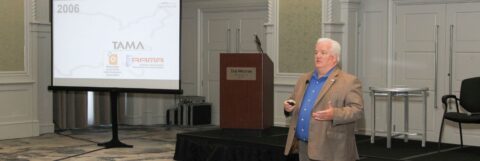Tulsa Regional Chamber
Oct. 18, 2024
Rhett Morgan
A glitch in a car’s instrument panel isn’t the easy fix it used to be.
In 1970, the electronics system represented 5% of the vehicle’s total cost, said Glenn Stevens, executive director at MichAuto. That figure is expected to rise to 50% by 2030.
“That’s mind-blowing,” Stevens said.
Stevens addressed changes and concerns in the automotive industry during a presentation at the Tulsa Regional Chamber’s Intercity Visit to Detroit.
More than 125 attendees from across northeast Oklahoma – including city and county elected officials, business leaders, regional partners, education administrators and young professionals – participated in the three-day Intercity Visit, which ended Oct. 9.
MichAuto, a nonprofit housed at the Detroit Regional Chamber, was established in 2007. The organization focuses on four areas: the talent pipeline, advocacy, industry transition and economic development.
Detroit remains North America’s epicenter of the automotive sector. Twenty-six vehicle manufacturing companies reside in southeast Michigan, Stevens said.
“There’s nothing like it in the world,” he said. “…It’s a big part of the culture here.
But with that culture comes concern, much of which is centered on the electrification of vehicles and foreign competition.
The United States doesn’t control the supply chain of raw materials for batteries or finished components for batteries. That distinction belongs to China, which produces more than 70% of the world’s lithium-ion batteries, Stevens said. The country also controls more than 70% of critical mineral refining, processing and manufacturing.
“This is a problem,” Stevens said. “…This is not sustainable. It’s a national security issue. It’s something that has to get resolved.”
Another issue for the United States is China’s prowess when it comes to automobile production. The Asian country manufactures about 40 million automobiles annually, about half the world’s demand, Stevens said.
It also is producing high-quality, electric vehicles at prices as low as $13,000.
“They are expanding globally,” Stevens said. “It’s a huge issue. It’s something we have to reckon with.
“Short-term tariffs and walls are not the answer. We have to figure this out. This is a global presence in a dynamic that did not exist a decade ago.”
While these challenges are daunting, Detroit has the minds to tackle them. A total of 70% of the automotive industry’s research and development capabilities are in southeast Michigan, Stevens said.
“Do we need to diversify away from the auto industry?” he said. “I would argue ‘no.’ We need to use it as a platform for diversification.
“…The auto industry is really the tech industry, the mobility industry and now clean energy. They are all one and the same. So, now we talk to (electric utilities) Consumers Power and Detroit Edison as much as we talk to GM because everybody’s working together. They have to work together because of the integrated supply chain and the way everything’s connected digitally and from a sustainability standpoint.”

